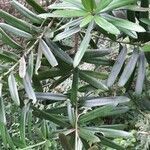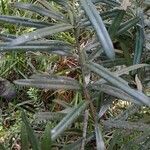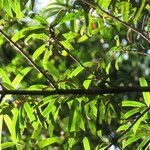A large tree. It grows 25 m high and taller. The trunk is up to 1.2 m across. The crown is dark green. The bark is smooth when young but becomes split and peels when mature. The leaves are long and narrow. They can be 9 cm long by 1 cm wide. They are glossy green. The leaves are arranged in spirals. The leaves on young trees are always larger than on mature trees. The male trees has cones which are 2.5 cm long. The female tree develops a fleshy receptacle on which one or 2 round blue seeds develop. The receptacle swells and is pink when ripe. It is edible.
Monoecious, evergreen tree, 10-33 m high; bark brown to grey, narrowly longitudinally fissured, flaking, forming plate-like scales. Buds glabrous; terminal bud 2.0-3.5 mm long. Twigs glabrous, stout, dull, green. Stems angular or round. Leaves alternate, simple; petioles glabrous or nearly so. Blade (20-)35-60(-100) x 5-13 mm, linear or oblong, apex and base acute, margins sometimes revolute. Fruiting cone 7-11 mm long, ellipsoid; receptacle swollen, fleshy, red to purplish.
Evergreen tree, up to 30 m high. Branchlets usually > 1.5 mm in diameter. Bark longitudinally fissured and peeling in strips. Leaves with blades orientated in a horizontal plane, blades narrowly elliptic, 60-80 x 5-10 mm, apex acute, margins entire, dark green or blue-green. Cones: male cones axillary, ± 50 x 5 mm; female cones borne on succulent, bright red, pink or reddish purple receptacles; Jul.-Sep.
Tree, up to 33 m high. Branchlets usually more than 1.5 mm in diameter. Leaf blade orientated in a horizontal plane, wider than 5 mm, shorter than 80 mm. Seeds borne on succulent receptacles.
Dioecious tree to 30 m. Leaves linear-elliptic, 35-60 x 6-10 mm. Seeds grey to purple, borne on nude stalks swollen above to form a fleshy reddish arillode.




